Workload Optimization Capability
Workload Optimization ensures that cloud resources are used efficiently and cost-effectively, by aligning resource selection, configuration, and usage with business needs and value.
By automating workload management tasks, your organization can optimize the use of cloud resources and ensure that you are only paying for what you need.
CloudMonitor features related to Workload Optimization

Cost by Resource Group
Often, cloud developers are not fully informed about the cost of a resource, and they are primarily tasked with addressing performance issues or meeting deadlines. The Cost by Resource Group can show the costs of those resources so they can be closely monitored before incurring any unnecessary expenses.
Recommendations
CloudMonitor provides a utilization analysis of resources, comparing it with the workload demands to identify any potential discrepancies. Based on this analysis CloudMonitor will provide you with various recommendations potentially resulting in cost savings for the organization.

Recommendation Alerts
CloudMonitor FinOps bot now alerts you when there is a new recommendation, on your Teams bot.


Resource Inventory
Gain granular insights into your cloud expenditure by categorizing cost-incurring resources by type. This enhances workload management and cost control, empowering you to identify usage patterns for more strategic capacity planning.
Workload Optimization Definition
Workload Optimization in the cloud is about ensuring that cloud resources are used efficiently and economically. This practice involves selecting the right resources, properly sizing them, configuring them effectively, and ensuring they are highly utilized while running only as needed. Engineers, in collaboration with FinOps, Product teams, and other stakeholders, lead this effort, following strategies that aim to align resource use with business value.
The objective is to ensure that the cloud spending is justified by the value created. Since cloud development is iterative, monitoring resource utilization over time is crucial to maintain or enhance performance and cost-effectiveness. This involves adjusting resources that are either overused or underutilized and optimizing even well-architected systems as new efficiencies become possible.
Workload Optimization is part of a broader set of capabilities within the Optimize Cloud Usage & Cost Domain, which also includes strategies for leveraging discounts, rearchitecting systems, managing software licenses, and improving sustainability. Among these, Workload Optimization is vital because it offers numerous ways to enhance the cost-effectiveness of cloud systems.
The process begins with the FinOps team identifying initial optimization opportunities. Over time, however, the Engineering team assumes greater responsibility, integrating optimization into both the design and ongoing management of systems. Continuous adaptation is necessary as cloud services evolve, requiring systems to be regularly updated to maintain optimal performance and cost efficiency.
Key strategies in Workload Optimization include:
- Waste Reduction: Removing unused resources such as idle storage or unnecessary backups to cut costs.
- Workload Management: Scheduling resources to run only when needed, reducing both costs and environmental impact.
- Scaling: Adjusting resource capacity based on actual demand to ensure efficiency during peak and off-peak times.
- Rightsizing: Modifying resources that are consistently underutilized to better match their workload demands.
- Modernization: Updating systems to utilize newer, more efficient cloud services as they become available.
Effective workload optimization requires ongoing collaboration across teams to balance technical, financial, and operational objectives. This continuous process not only manages costs but also aligns cloud resource usage with overall business strategies, ensuring resources are both effective and economical.
